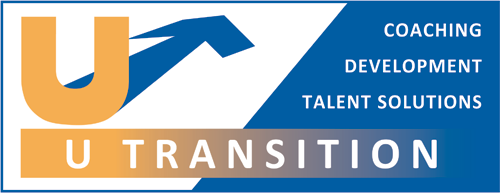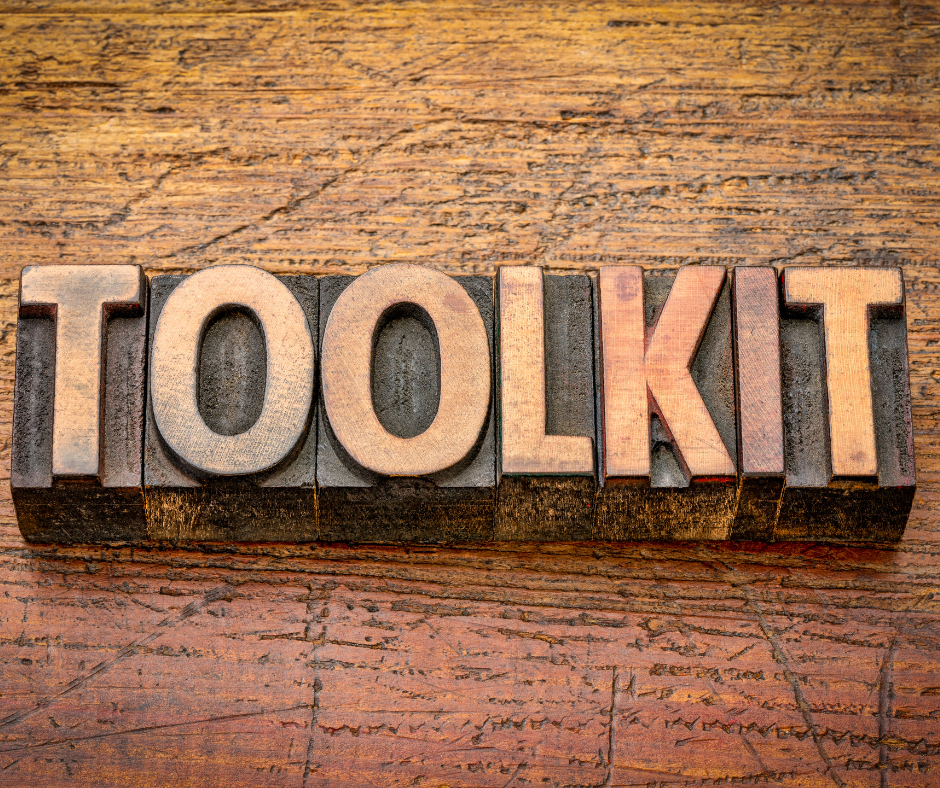
 What should be in your Coaching Toolkit?
What should be in your Coaching Toolkit?
Your coaching toolkit should ideally consist of various resources, techniques, tools and skills that you can draw upon to support your coachee or your team effectively.
Ideally it should not be a static thing but a versatile and adaptable toolkit which equips you with the resources needed to support people effectively and should evolve and grow as you gain experience and expand your skills.
Coaching is not a one size fits all. Everyone is unique and everyone’s need are unique ….and are often situational.
It’s important to select the appropriate tool or technique that aligns with the coaching objectives, coachee preferences, ethical considerations and relevant stage of the coaching process or employee journey.
The best tools are the ones that facilitate growth, self-discovery, and empower the coachee to achieve their goals. Equally, what you need today may not be what you need in 6 months time so the more resources’ you have to hand and the more flexible your approach, the better equipped you will be to support in the right way with the right tool or technique at the right time and to be able to remain in control and change calmly and confidently to a different technique if the one you are using isn’t getting the results.
Here are 6 essential tools or techniques that can be included in your coaching toolkit:
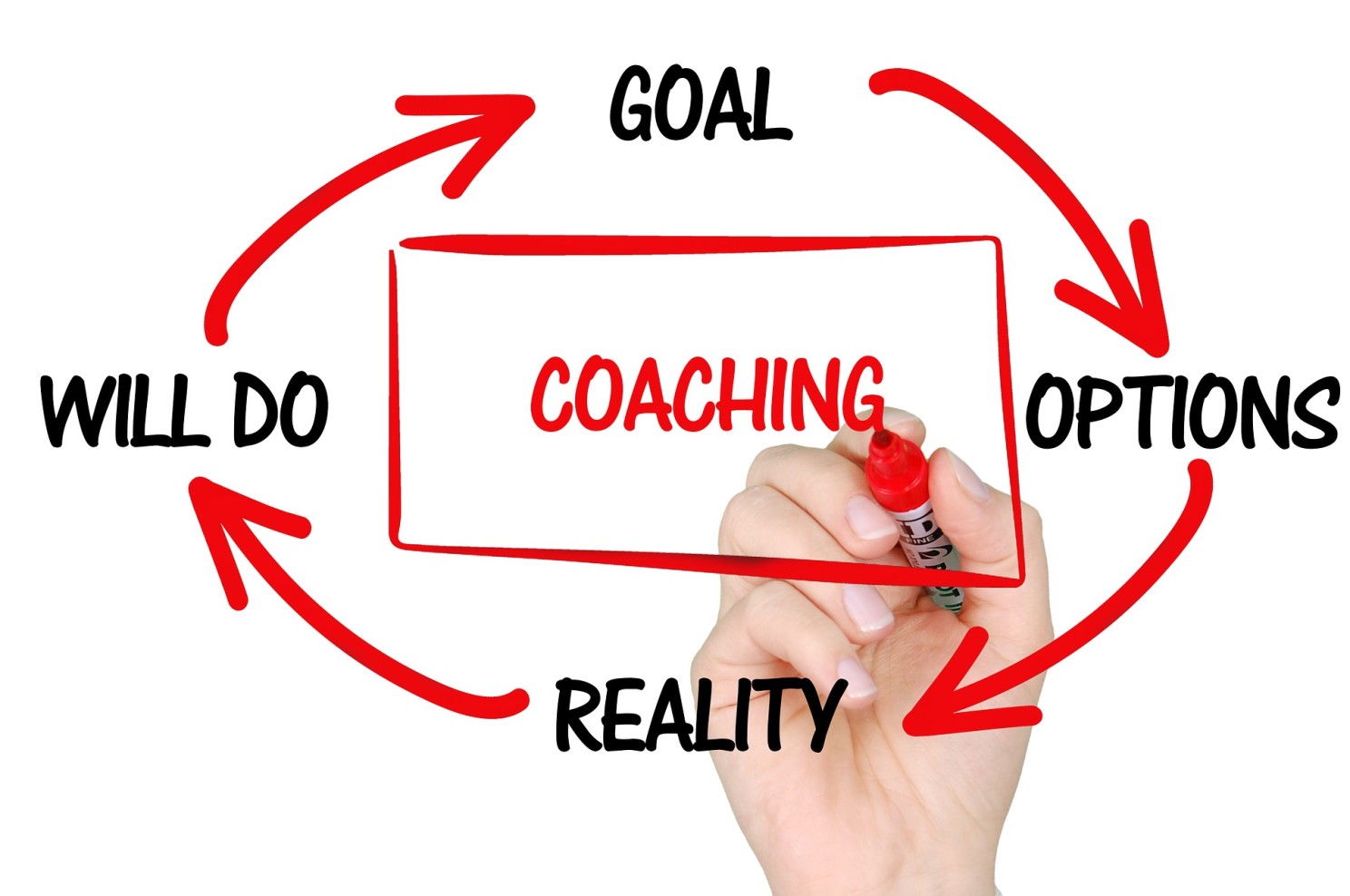 A good Coaching Model or framework: Models and frameworks such as the GROW, OSKAR, CLEAR, DART models etc provide a structured approach through which coaching conversations and goal setting can take place. These can be really useful to help keep the conversation on track and help you as coach stay focussed, especially when you are learning to coach. However, be careful not to be wedded to the structure. The most powerful conversations will come from being fully present, listening empathically and asking powerful questions based on where the conversation needs to go not what the next question in the model says it should be.
A good Coaching Model or framework: Models and frameworks such as the GROW, OSKAR, CLEAR, DART models etc provide a structured approach through which coaching conversations and goal setting can take place. These can be really useful to help keep the conversation on track and help you as coach stay focussed, especially when you are learning to coach. However, be careful not to be wedded to the structure. The most powerful conversations will come from being fully present, listening empathically and asking powerful questions based on where the conversation needs to go not what the next question in the model says it should be.
I personally like the GROW model. Created by Sir John Whitmore in the late 1980s, it’s one of the most popular coaching models for setting goals, improving performance, and coaching. It’s simple and effective.
- Goal – where do you want to be? Define a goal that is motivating, inspiring, and drives success. It could be a behaviour that needs to change or an aspiration to be reached, something tangible or less tangible. Spend time on the goal. If the goal is not clarified properly the quality of the conversation will be poor.
- Reality – where are you now? Understand where are they now, what have they tried, what are the facts etc and identify any barriers that are causing issues. Establish where they want to be. Then recognise strengths, qualities, and resources that may help.
- Options – what could you do to get there? Consider the options for moving forward. Challenge the coachee with imaginative / possibility / magic wand coaching questions. For example, “if money were no object, what would you do? If time were not a factor, how would you proceed? If you had a magic wand what would you make happen? What other options are there?”
- Will – what will you do? The call to action – Now that there is a list of options, agree on the actions, timing, accountability, and reporting. The coachee must commit to what they will do next. Your role as coach is to help them select the best options not solve the problem for them.
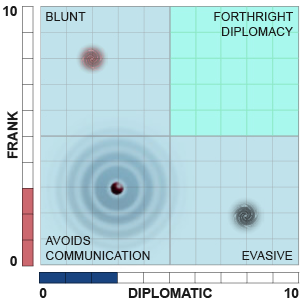
Assessment Instruments: There are many assessments available. Tools like behavioural assessments (e.g. Harrison Assessments) personality assessments (e.g. Myers-Briggs Type Indicator, DISC, Insights), emotional intelligence assessments or 360-degree feedback surveys can provide valuable insights and support in self-awareness and development. These can be useful as they provide an opportunity for objectivity to be the starting point of the journey. A skilled coach can then use questions to explore, stretch and empower transforming mindsets, behaviours, skills and results. Assessments should be debriefed by a qualified practitioner.
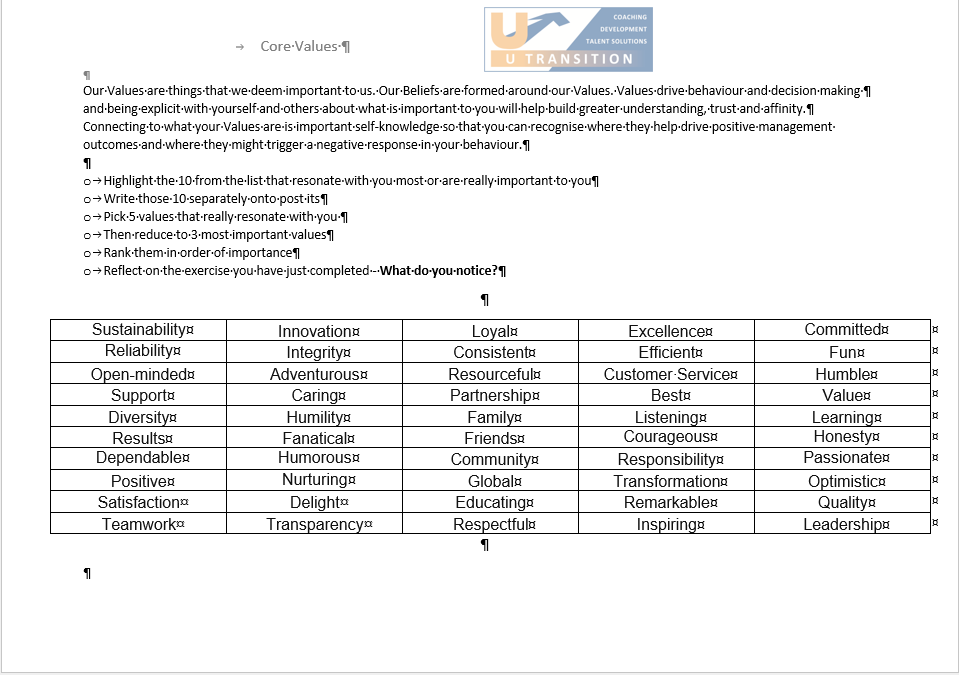
Values Elicitation Exercises: activities and discussions that facilitate and help clients identify and prioritise their core values. Our Values are things that we deem important and make us who we are. They can include concepts like equality, honesty, education, effort, perseverance, loyalty, achievement, courage and many others. Values drive behaviour and decision making and being explicit with yourself and others about what is important to you will help build greater understanding, trust and affinity. Connecting to what your Values are is important self-knowledge so that you can recognise where they help drive positive management outcomes and where they might trigger a negative response in your behaviour. When our values are crossed we feel it physically and emotionally and it can trigger all sorts of responses and behaviours. This exploration can guide coachees in raising awareness of their values, the impact of them in the day to day and under stress and explore potential options, consequences, and the importance of values in decision-making processes and in aligning values to actions.
Exercise
- Ask the coachee what’s important to you in xxx (eg work, your career, life etc) use powerful questions to elicit a list .
- Ask the coachee to highlight the 10 from the list that resonate most or are really important
- Write those 10 separately onto post its
- Then pick 5 of those original 10 values that really resonate with you
- Then reduce to 3 most important values
- Rank them in order of importance
- Reflect on the exercise you have just completed – What do you notice?
Then discuss
- Check for values alignment
- These values and any strong beliefs that sit around them in relation to you on a good day?
- These values and any strong beliefs that sit around them in relation to you on a not so good day?
- Reflecting on your values, how they might positively support your team’s experience of you?
- How does it enable the performance and engagement of the people who work for you / with you? Do your behaviours inhibit performance and engagement for others?
 Reflection Journaling : Journaling exercises can help you to explore thoughts, emotions, and experiences more deeply. Coaches can provide prompts or guided questions to facilitate journaling as a self-reflective practice. Use the “Journal” anacronym as a template
Reflection Journaling : Journaling exercises can help you to explore thoughts, emotions, and experiences more deeply. Coaches can provide prompts or guided questions to facilitate journaling as a self-reflective practice. Use the “Journal” anacronym as a template
- (J) Judgment-free: Write about whatever you like. This journal is personal, private, and a safe space for you to express your thoughts and feelings. Without judgment.
- (O) Observation: Write down things that happen to you and spend some time thinking about how you interpret them. Try to take a holistic, objective view and try to view these events as a third person.
- (U) Understanding: What do you understand about the events that happen to you? When you understand how you view something, you may be able to understand why you view it that way.
- (R) Revelation: What does it reveal for you? The process of journaling and documenting can often reveal desires, aspirations and underlying thoughts, which can then tie into your general state of being. This is valuable insight which can often reveal things previously unknown or unspoken.
- (N) Needs Assessment: Journaling can help you draw attention to problems and potential solutions. Writing has often been attributed to making things appear simpler and clearer and therefore highlighting needs and assessing possible solutions.
- (A) Awareness: Documenting experiences and the thoughts regarding them can help you develop a greater understanding and awareness of the environment around you, giving you perspective on a bigger arena.
- (L) Life: Studies prove that journaling is known to have therapeutic effects. It is known to help reduce stress levels so by taking up a journaling practice, you’re also helping with your overall well being.
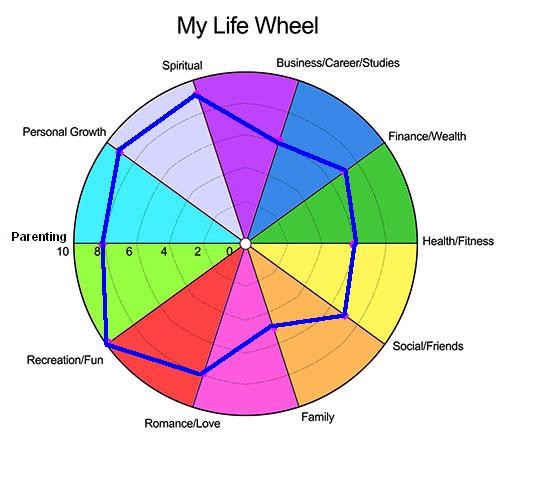 Wheel of Life: The Wheel of Life tool visually represents various areas of life, allowing you to assess your satisfaction levels in each area and identify areas for growth and balance. Across the spectrum of coaching, the ‘Wheel of Life’ is considered an invaluable and highly personalised tool. It’s designed to help you find out which areas of your life you are happy with and which areas you want to focus on in an attempt to improve your quality of life.
Wheel of Life: The Wheel of Life tool visually represents various areas of life, allowing you to assess your satisfaction levels in each area and identify areas for growth and balance. Across the spectrum of coaching, the ‘Wheel of Life’ is considered an invaluable and highly personalised tool. It’s designed to help you find out which areas of your life you are happy with and which areas you want to focus on in an attempt to improve your quality of life.
Step 1: Take a look at the 10 categories: (you can pick your own categories it doesn’t have to be these)
- eg Health / Friends & Family / Significant other / Personal Growth / Fun & Leisure / Home Environment / Career / Money
Then ask them to briefly think about what, in their opinion, would be representative of being fulfilled in each category.
Step 2: Draw a line in each segment. The centre of the wheel represents the lowest value of satisfaction, 0; and the edge of the wheel represents the highest value of satisfaction, 10. Mark the point that you feel is appropriate for each segment and join the dots of each segment to each other.
- As a result of this exercise, your will have a visual map that will look almost like a spider web. This visual map will give your client a general idea of their desired state of being in relation to their current state.
I often use the wheel of life tool alongside the Harrison Assessment.
The NLP Meta Mirror Technique
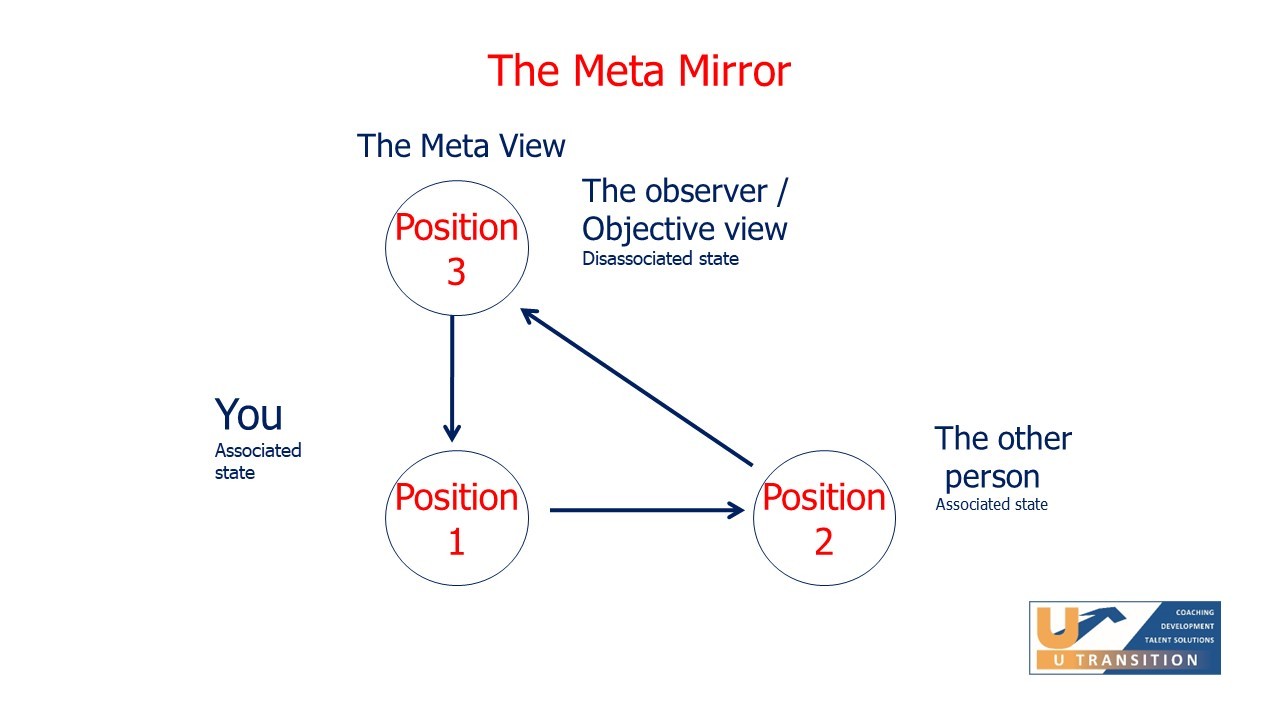 The meta mirror was co created by Robert Dilts. This technique is excellent for gaining insight into other viewpoints and can really help to give a different perspective in areas like conflicts, negotiations, strategic planning, preparing for meetings, relationships, interviews, dealing with issues etc.
The meta mirror was co created by Robert Dilts. This technique is excellent for gaining insight into other viewpoints and can really help to give a different perspective in areas like conflicts, negotiations, strategic planning, preparing for meetings, relationships, interviews, dealing with issues etc.
I find it works better if used with an external person, like a coach, asking questions but with practice you can learn to do it effectively alone.
Whilst there are 5 originally stated positions, many practitioners simply focus and use the first 3 for most situations. The process is about supporting an objective perspective and creating disassociation from thoughts and beliefs
- First position – your own position on the situation.
- Second position – viewing it from the other persons perspective.
- Third position – you being ‘a fly on the wall’, having a more objective view.
In the first position you begin by observing the situation and relationship from your own perspective. You consider your thoughts, feelings, and experiences through your own eyes. You reflect on your behaviour, words, and actions, and how your views may have changed in the relationship or situation.
Next, you explores the other person’s perspective (second position). You step into the other person’s shoes and try to understand how they view the relationship and the situation. The coach may suggest closing your eyes to enhance focus. Similar questions are used as in the first position, but from the other person’s point of view.
Finally, you take on the role of a neutral observer (third position). You imagine being a “fly on the wall” and observe the interactions between both parties. You pay attention to the behaviours, perceptions, experiences, thoughts, and feelings of both individuals. You gain a more objective understanding of the situation and considers what can be learned from it. Emotion is reduced in this position.
You keep moving back through the positions until you have resolution and solution.
